Networking and Security - Report on OSI and TCP/IP referencing model
VerifiedAdded on 2023/06/04
|6
|2003
|370
AI Summary
This report examines how data exchange is made among processing networks and frameworks. It includes a short review of layers of OSI model and TCP/IP referencing model that makes this availability possible.
Contribute Materials
Your contribution can guide someone’s learning journey. Share your
documents today.
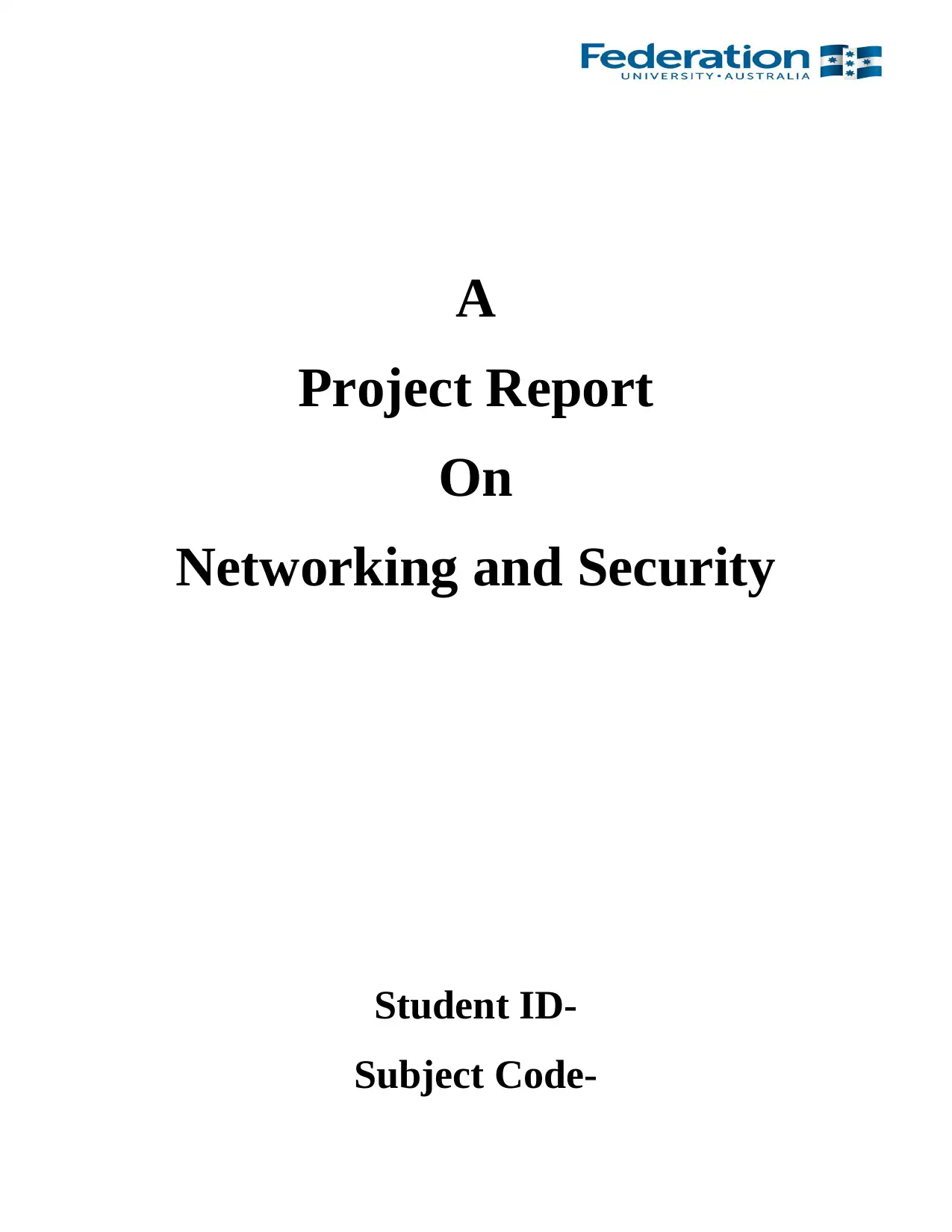
A
Project Report
On
Networking and Security
Student ID-
Subject Code-
Project Report
On
Networking and Security
Student ID-
Subject Code-
Secure Best Marks with AI Grader
Need help grading? Try our AI Grader for instant feedback on your assignments.
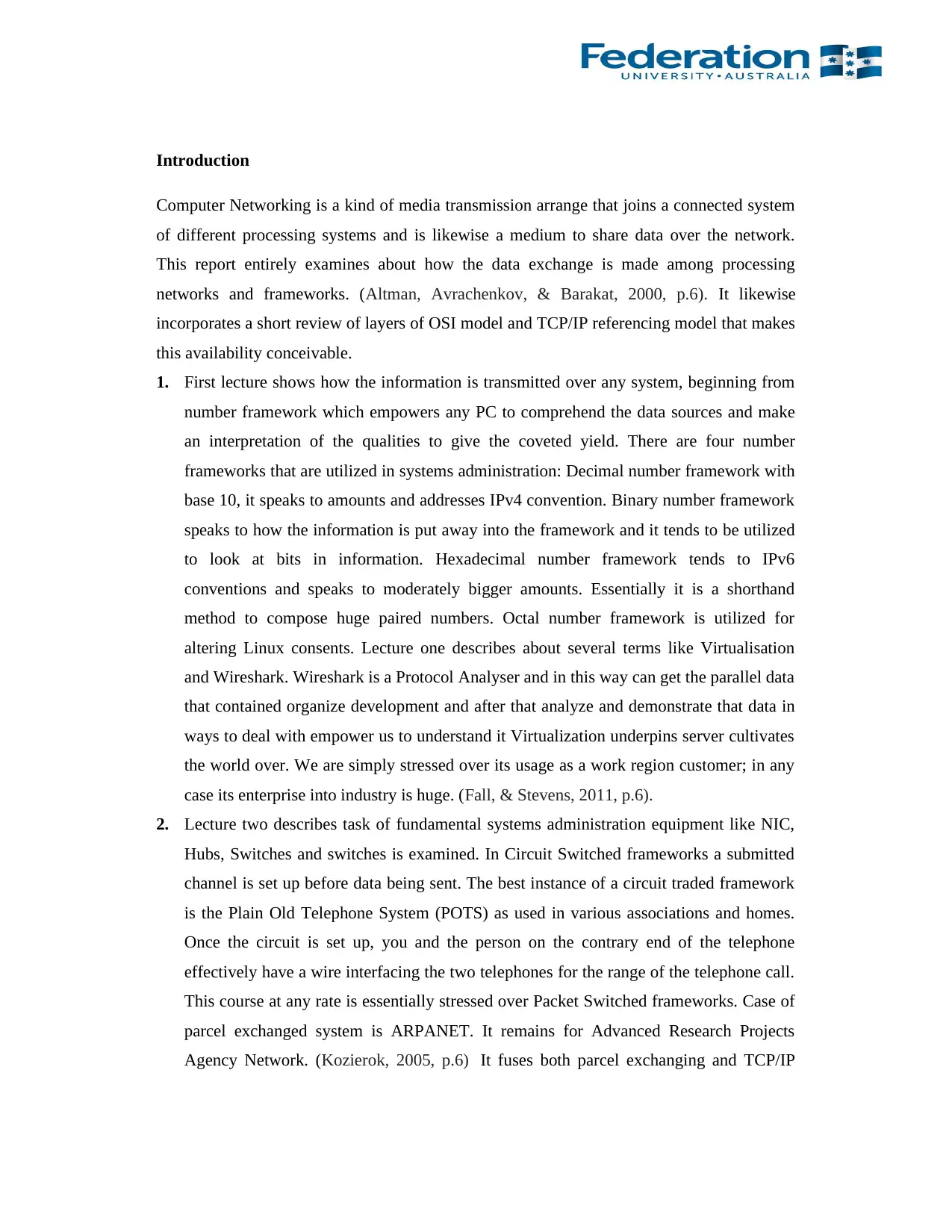
Introduction
Computer Networking is a kind of media transmission arrange that joins a connected system
of different processing systems and is likewise a medium to share data over the network.
This report entirely examines about how the data exchange is made among processing
networks and frameworks. (Altman, Avrachenkov, & Barakat, 2000, p.6). It likewise
incorporates a short review of layers of OSI model and TCP/IP referencing model that makes
this availability conceivable.
1. First lecture shows how the information is transmitted over any system, beginning from
number framework which empowers any PC to comprehend the data sources and make
an interpretation of the qualities to give the coveted yield. There are four number
frameworks that are utilized in systems administration: Decimal number framework with
base 10, it speaks to amounts and addresses IPv4 convention. Binary number framework
speaks to how the information is put away into the framework and it tends to be utilized
to look at bits in information. Hexadecimal number framework tends to IPv6
conventions and speaks to moderately bigger amounts. Essentially it is a shorthand
method to compose huge paired numbers. Octal number framework is utilized for
altering Linux consents. Lecture one describes about several terms like Virtualisation
and Wireshark. Wireshark is a Protocol Analyser and in this way can get the parallel data
that contained organize development and after that analyze and demonstrate that data in
ways to deal with empower us to understand it Virtualization underpins server cultivates
the world over. We are simply stressed over its usage as a work region customer; in any
case its enterprise into industry is huge. (Fall, & Stevens, 2011, p.6).
2. Lecture two describes task of fundamental systems administration equipment like NIC,
Hubs, Switches and switches is examined. In Circuit Switched frameworks a submitted
channel is set up before data being sent. The best instance of a circuit traded framework
is the Plain Old Telephone System (POTS) as used in various associations and homes.
Once the circuit is set up, you and the person on the contrary end of the telephone
effectively have a wire interfacing the two telephones for the range of the telephone call.
This course at any rate is essentially stressed over Packet Switched frameworks. Case of
parcel exchanged system is ARPANET. It remains for Advanced Research Projects
Agency Network. (Kozierok, 2005, p.6) It fuses both parcel exchanging and TCP/IP
Computer Networking is a kind of media transmission arrange that joins a connected system
of different processing systems and is likewise a medium to share data over the network.
This report entirely examines about how the data exchange is made among processing
networks and frameworks. (Altman, Avrachenkov, & Barakat, 2000, p.6). It likewise
incorporates a short review of layers of OSI model and TCP/IP referencing model that makes
this availability conceivable.
1. First lecture shows how the information is transmitted over any system, beginning from
number framework which empowers any PC to comprehend the data sources and make
an interpretation of the qualities to give the coveted yield. There are four number
frameworks that are utilized in systems administration: Decimal number framework with
base 10, it speaks to amounts and addresses IPv4 convention. Binary number framework
speaks to how the information is put away into the framework and it tends to be utilized
to look at bits in information. Hexadecimal number framework tends to IPv6
conventions and speaks to moderately bigger amounts. Essentially it is a shorthand
method to compose huge paired numbers. Octal number framework is utilized for
altering Linux consents. Lecture one describes about several terms like Virtualisation
and Wireshark. Wireshark is a Protocol Analyser and in this way can get the parallel data
that contained organize development and after that analyze and demonstrate that data in
ways to deal with empower us to understand it Virtualization underpins server cultivates
the world over. We are simply stressed over its usage as a work region customer; in any
case its enterprise into industry is huge. (Fall, & Stevens, 2011, p.6).
2. Lecture two describes task of fundamental systems administration equipment like NIC,
Hubs, Switches and switches is examined. In Circuit Switched frameworks a submitted
channel is set up before data being sent. The best instance of a circuit traded framework
is the Plain Old Telephone System (POTS) as used in various associations and homes.
Once the circuit is set up, you and the person on the contrary end of the telephone
effectively have a wire interfacing the two telephones for the range of the telephone call.
This course at any rate is essentially stressed over Packet Switched frameworks. Case of
parcel exchanged system is ARPANET. It remains for Advanced Research Projects
Agency Network. (Kozierok, 2005, p.6) It fuses both parcel exchanging and TCP/IP
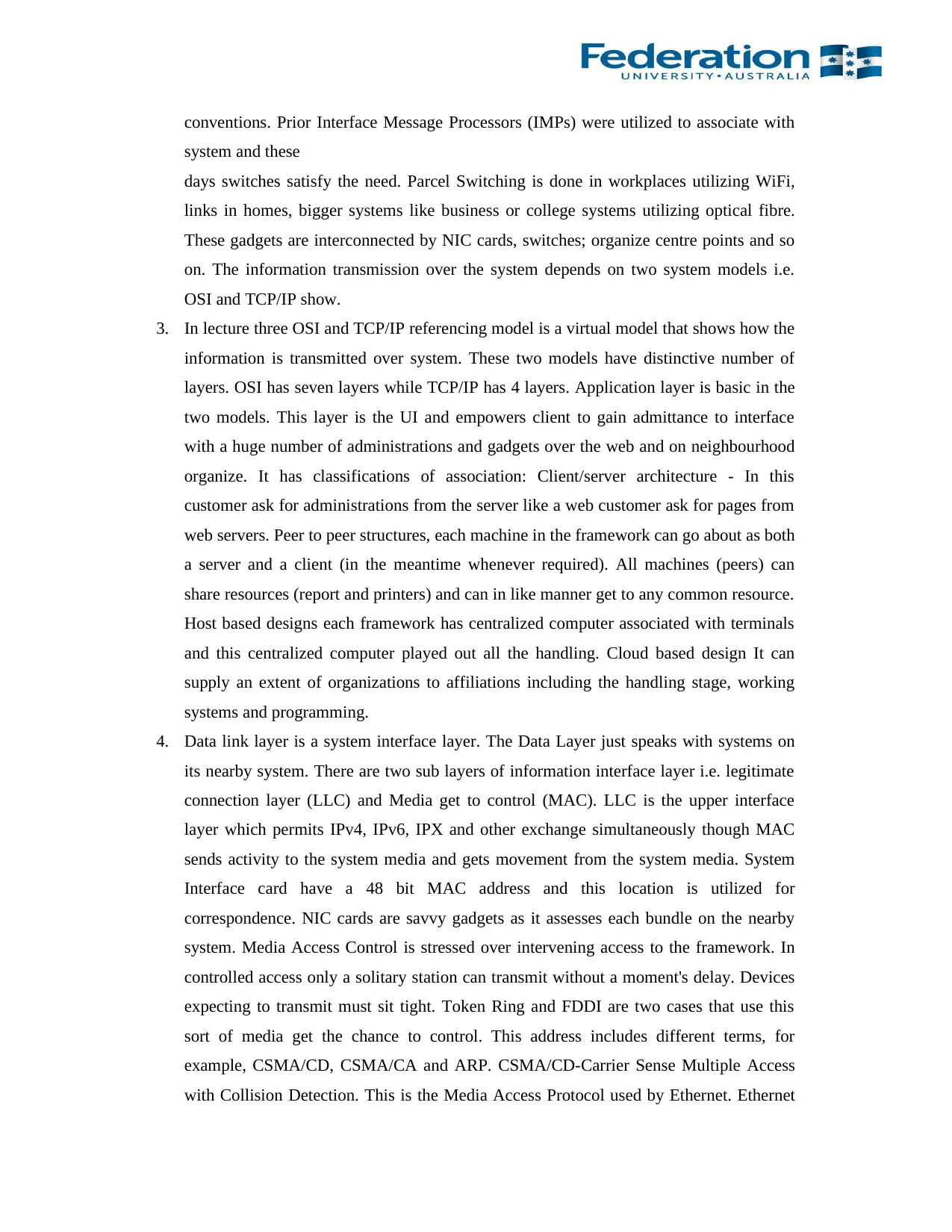
conventions. Prior Interface Message Processors (IMPs) were utilized to associate with
system and these
days switches satisfy the need. Parcel Switching is done in workplaces utilizing WiFi,
links in homes, bigger systems like business or college systems utilizing optical fibre.
These gadgets are interconnected by NIC cards, switches; organize centre points and so
on. The information transmission over the system depends on two system models i.e.
OSI and TCP/IP show.
3. In lecture three OSI and TCP/IP referencing model is a virtual model that shows how the
information is transmitted over system. These two models have distinctive number of
layers. OSI has seven layers while TCP/IP has 4 layers. Application layer is basic in the
two models. This layer is the UI and empowers client to gain admittance to interface
with a huge number of administrations and gadgets over the web and on neighbourhood
organize. It has classifications of association: Client/server architecture - In this
customer ask for administrations from the server like a web customer ask for pages from
web servers. Peer to peer structures, each machine in the framework can go about as both
a server and a client (in the meantime whenever required). All machines (peers) can
share resources (report and printers) and can in like manner get to any common resource.
Host based designs each framework has centralized computer associated with terminals
and this centralized computer played out all the handling. Cloud based design It can
supply an extent of organizations to affiliations including the handling stage, working
systems and programming.
4. Data link layer is a system interface layer. The Data Layer just speaks with systems on
its nearby system. There are two sub layers of information interface layer i.e. legitimate
connection layer (LLC) and Media get to control (MAC). LLC is the upper interface
layer which permits IPv4, IPv6, IPX and other exchange simultaneously though MAC
sends activity to the system media and gets movement from the system media. System
Interface card have a 48 bit MAC address and this location is utilized for
correspondence. NIC cards are savvy gadgets as it assesses each bundle on the nearby
system. Media Access Control is stressed over intervening access to the framework. In
controlled access only a solitary station can transmit without a moment's delay. Devices
expecting to transmit must sit tight. Token Ring and FDDI are two cases that use this
sort of media get the chance to control. This address includes different terms, for
example, CSMA/CD, CSMA/CA and ARP. CSMA/CD-Carrier Sense Multiple Access
with Collision Detection. This is the Media Access Protocol used by Ethernet. Ethernet
system and these
days switches satisfy the need. Parcel Switching is done in workplaces utilizing WiFi,
links in homes, bigger systems like business or college systems utilizing optical fibre.
These gadgets are interconnected by NIC cards, switches; organize centre points and so
on. The information transmission over the system depends on two system models i.e.
OSI and TCP/IP show.
3. In lecture three OSI and TCP/IP referencing model is a virtual model that shows how the
information is transmitted over system. These two models have distinctive number of
layers. OSI has seven layers while TCP/IP has 4 layers. Application layer is basic in the
two models. This layer is the UI and empowers client to gain admittance to interface
with a huge number of administrations and gadgets over the web and on neighbourhood
organize. It has classifications of association: Client/server architecture - In this
customer ask for administrations from the server like a web customer ask for pages from
web servers. Peer to peer structures, each machine in the framework can go about as both
a server and a client (in the meantime whenever required). All machines (peers) can
share resources (report and printers) and can in like manner get to any common resource.
Host based designs each framework has centralized computer associated with terminals
and this centralized computer played out all the handling. Cloud based design It can
supply an extent of organizations to affiliations including the handling stage, working
systems and programming.
4. Data link layer is a system interface layer. The Data Layer just speaks with systems on
its nearby system. There are two sub layers of information interface layer i.e. legitimate
connection layer (LLC) and Media get to control (MAC). LLC is the upper interface
layer which permits IPv4, IPv6, IPX and other exchange simultaneously though MAC
sends activity to the system media and gets movement from the system media. System
Interface card have a 48 bit MAC address and this location is utilized for
correspondence. NIC cards are savvy gadgets as it assesses each bundle on the nearby
system. Media Access Control is stressed over intervening access to the framework. In
controlled access only a solitary station can transmit without a moment's delay. Devices
expecting to transmit must sit tight. Token Ring and FDDI are two cases that use this
sort of media get the chance to control. This address includes different terms, for
example, CSMA/CD, CSMA/CA and ARP. CSMA/CD-Carrier Sense Multiple Access
with Collision Detection. This is the Media Access Protocol used by Ethernet. Ethernet
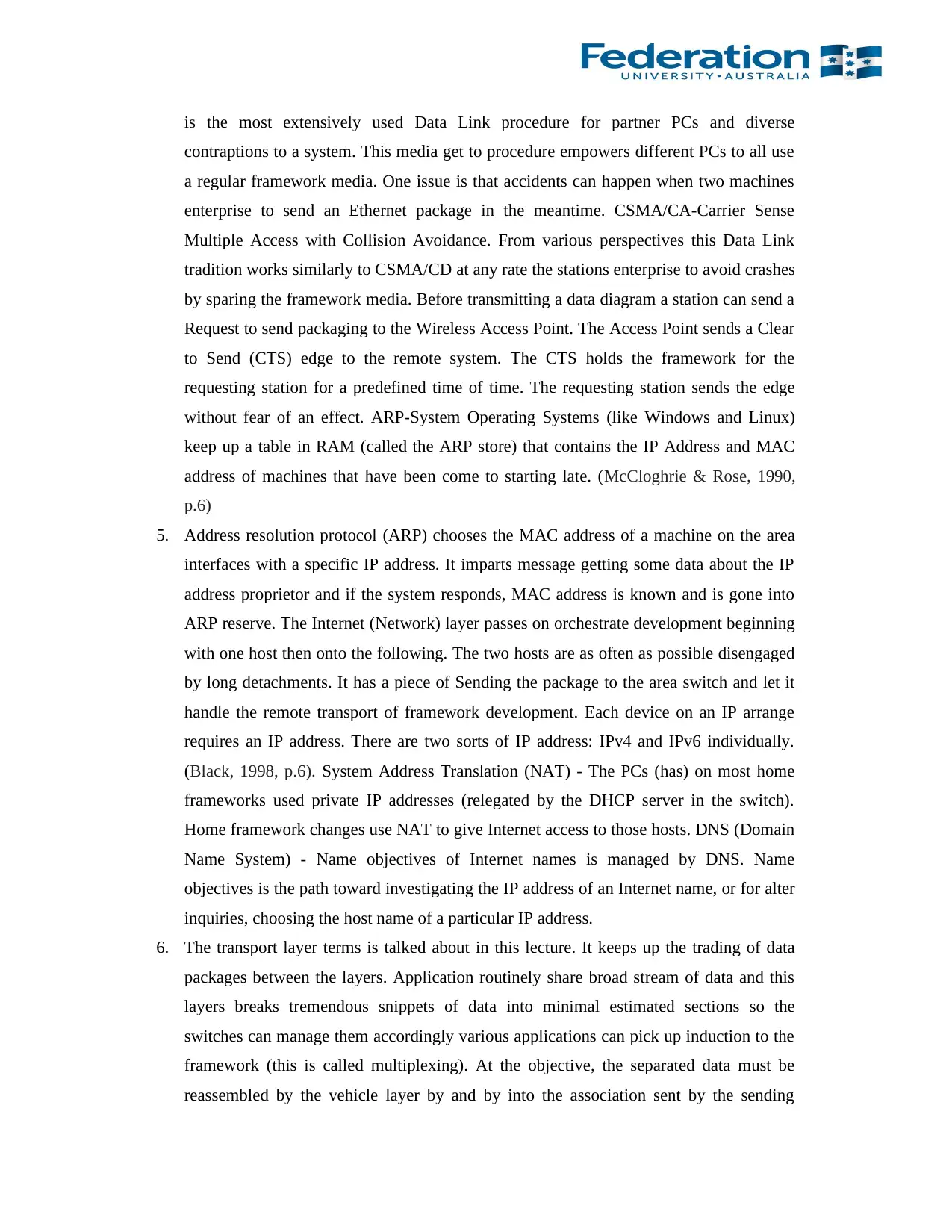
is the most extensively used Data Link procedure for partner PCs and diverse
contraptions to a system. This media get to procedure empowers different PCs to all use
a regular framework media. One issue is that accidents can happen when two machines
enterprise to send an Ethernet package in the meantime. CSMA/CA-Carrier Sense
Multiple Access with Collision Avoidance. From various perspectives this Data Link
tradition works similarly to CSMA/CD at any rate the stations enterprise to avoid crashes
by sparing the framework media. Before transmitting a data diagram a station can send a
Request to send packaging to the Wireless Access Point. The Access Point sends a Clear
to Send (CTS) edge to the remote system. The CTS holds the framework for the
requesting station for a predefined time of time. The requesting station sends the edge
without fear of an effect. ARP-System Operating Systems (like Windows and Linux)
keep up a table in RAM (called the ARP store) that contains the IP Address and MAC
address of machines that have been come to starting late. (McCloghrie & Rose, 1990,
p.6)
5. Address resolution protocol (ARP) chooses the MAC address of a machine on the area
interfaces with a specific IP address. It imparts message getting some data about the IP
address proprietor and if the system responds, MAC address is known and is gone into
ARP reserve. The Internet (Network) layer passes on orchestrate development beginning
with one host then onto the following. The two hosts are as often as possible disengaged
by long detachments. It has a piece of Sending the package to the area switch and let it
handle the remote transport of framework development. Each device on an IP arrange
requires an IP address. There are two sorts of IP address: IPv4 and IPv6 individually.
(Black, 1998, p.6). System Address Translation (NAT) - The PCs (has) on most home
frameworks used private IP addresses (relegated by the DHCP server in the switch).
Home framework changes use NAT to give Internet access to those hosts. DNS (Domain
Name System) - Name objectives of Internet names is managed by DNS. Name
objectives is the path toward investigating the IP address of an Internet name, or for alter
inquiries, choosing the host name of a particular IP address.
6. The transport layer terms is talked about in this lecture. It keeps up the trading of data
packages between the layers. Application routinely share broad stream of data and this
layers breaks tremendous snippets of data into minimal estimated sections so the
switches can manage them accordingly various applications can pick up induction to the
framework (this is called multiplexing). At the objective, the separated data must be
reassembled by the vehicle layer by and by into the association sent by the sending
contraptions to a system. This media get to procedure empowers different PCs to all use
a regular framework media. One issue is that accidents can happen when two machines
enterprise to send an Ethernet package in the meantime. CSMA/CA-Carrier Sense
Multiple Access with Collision Avoidance. From various perspectives this Data Link
tradition works similarly to CSMA/CD at any rate the stations enterprise to avoid crashes
by sparing the framework media. Before transmitting a data diagram a station can send a
Request to send packaging to the Wireless Access Point. The Access Point sends a Clear
to Send (CTS) edge to the remote system. The CTS holds the framework for the
requesting station for a predefined time of time. The requesting station sends the edge
without fear of an effect. ARP-System Operating Systems (like Windows and Linux)
keep up a table in RAM (called the ARP store) that contains the IP Address and MAC
address of machines that have been come to starting late. (McCloghrie & Rose, 1990,
p.6)
5. Address resolution protocol (ARP) chooses the MAC address of a machine on the area
interfaces with a specific IP address. It imparts message getting some data about the IP
address proprietor and if the system responds, MAC address is known and is gone into
ARP reserve. The Internet (Network) layer passes on orchestrate development beginning
with one host then onto the following. The two hosts are as often as possible disengaged
by long detachments. It has a piece of Sending the package to the area switch and let it
handle the remote transport of framework development. Each device on an IP arrange
requires an IP address. There are two sorts of IP address: IPv4 and IPv6 individually.
(Black, 1998, p.6). System Address Translation (NAT) - The PCs (has) on most home
frameworks used private IP addresses (relegated by the DHCP server in the switch).
Home framework changes use NAT to give Internet access to those hosts. DNS (Domain
Name System) - Name objectives of Internet names is managed by DNS. Name
objectives is the path toward investigating the IP address of an Internet name, or for alter
inquiries, choosing the host name of a particular IP address.
6. The transport layer terms is talked about in this lecture. It keeps up the trading of data
packages between the layers. Application routinely share broad stream of data and this
layers breaks tremendous snippets of data into minimal estimated sections so the
switches can manage them accordingly various applications can pick up induction to the
framework (this is called multiplexing). At the objective, the separated data must be
reassembled by the vehicle layer by and by into the association sent by the sending
Secure Best Marks with AI Grader
Need help grading? Try our AI Grader for instant feedback on your assignments.
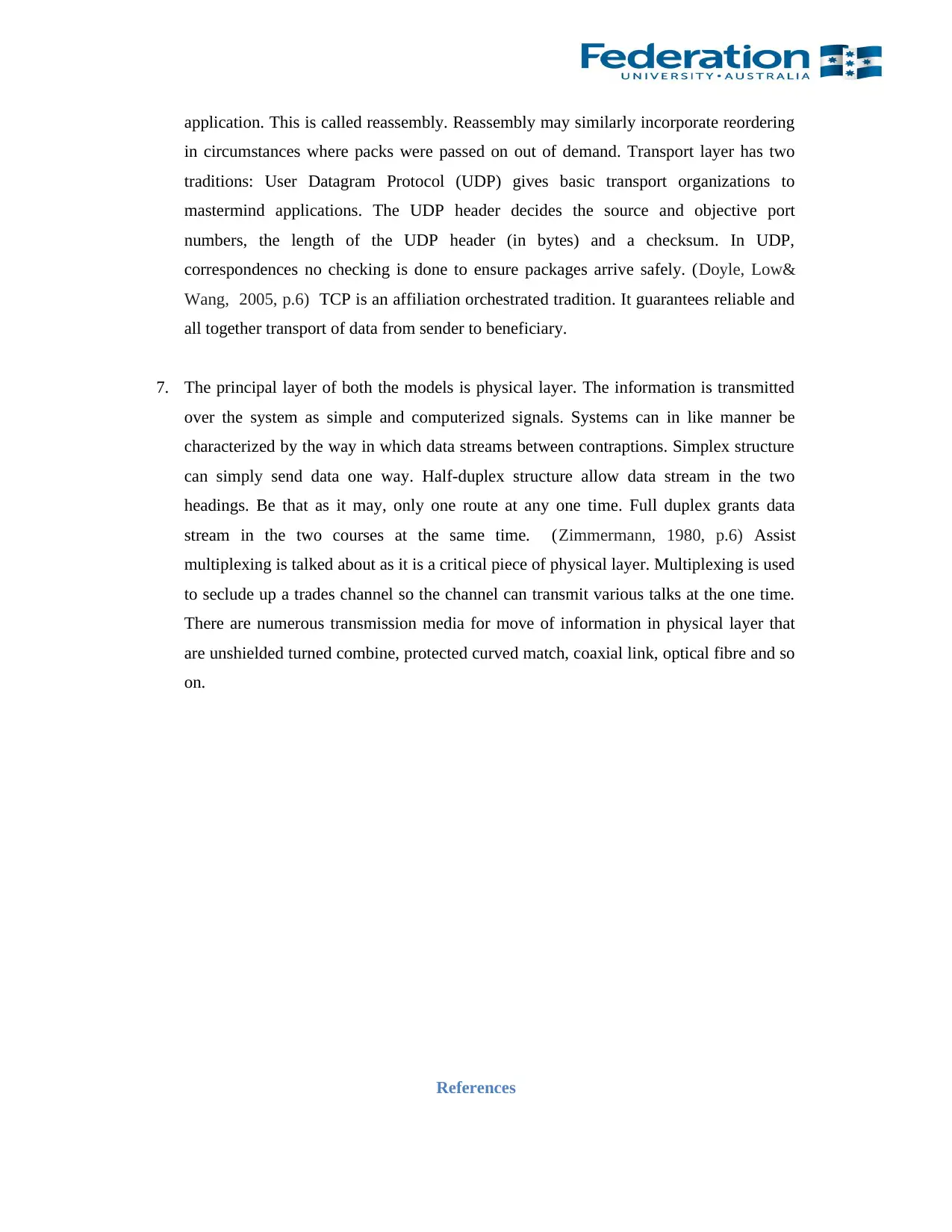
application. This is called reassembly. Reassembly may similarly incorporate reordering
in circumstances where packs were passed on out of demand. Transport layer has two
traditions: User Datagram Protocol (UDP) gives basic transport organizations to
mastermind applications. The UDP header decides the source and objective port
numbers, the length of the UDP header (in bytes) and a checksum. In UDP,
correspondences no checking is done to ensure packages arrive safely. (Doyle, Low&
Wang, 2005, p.6) TCP is an affiliation orchestrated tradition. It guarantees reliable and
all together transport of data from sender to beneficiary.
7. The principal layer of both the models is physical layer. The information is transmitted
over the system as simple and computerized signals. Systems can in like manner be
characterized by the way in which data streams between contraptions. Simplex structure
can simply send data one way. Half-duplex structure allow data stream in the two
headings. Be that as it may, only one route at any one time. Full duplex grants data
stream in the two courses at the same time. (Zimmermann, 1980, p.6) Assist
multiplexing is talked about as it is a critical piece of physical layer. Multiplexing is used
to seclude up a trades channel so the channel can transmit various talks at the one time.
There are numerous transmission media for move of information in physical layer that
are unshielded turned combine, protected curved match, coaxial link, optical fibre and so
on.
References
in circumstances where packs were passed on out of demand. Transport layer has two
traditions: User Datagram Protocol (UDP) gives basic transport organizations to
mastermind applications. The UDP header decides the source and objective port
numbers, the length of the UDP header (in bytes) and a checksum. In UDP,
correspondences no checking is done to ensure packages arrive safely. (Doyle, Low&
Wang, 2005, p.6) TCP is an affiliation orchestrated tradition. It guarantees reliable and
all together transport of data from sender to beneficiary.
7. The principal layer of both the models is physical layer. The information is transmitted
over the system as simple and computerized signals. Systems can in like manner be
characterized by the way in which data streams between contraptions. Simplex structure
can simply send data one way. Half-duplex structure allow data stream in the two
headings. Be that as it may, only one route at any one time. Full duplex grants data
stream in the two courses at the same time. (Zimmermann, 1980, p.6) Assist
multiplexing is talked about as it is a critical piece of physical layer. Multiplexing is used
to seclude up a trades channel so the channel can transmit various talks at the one time.
There are numerous transmission media for move of information in physical layer that
are unshielded turned combine, protected curved match, coaxial link, optical fibre and so
on.
References
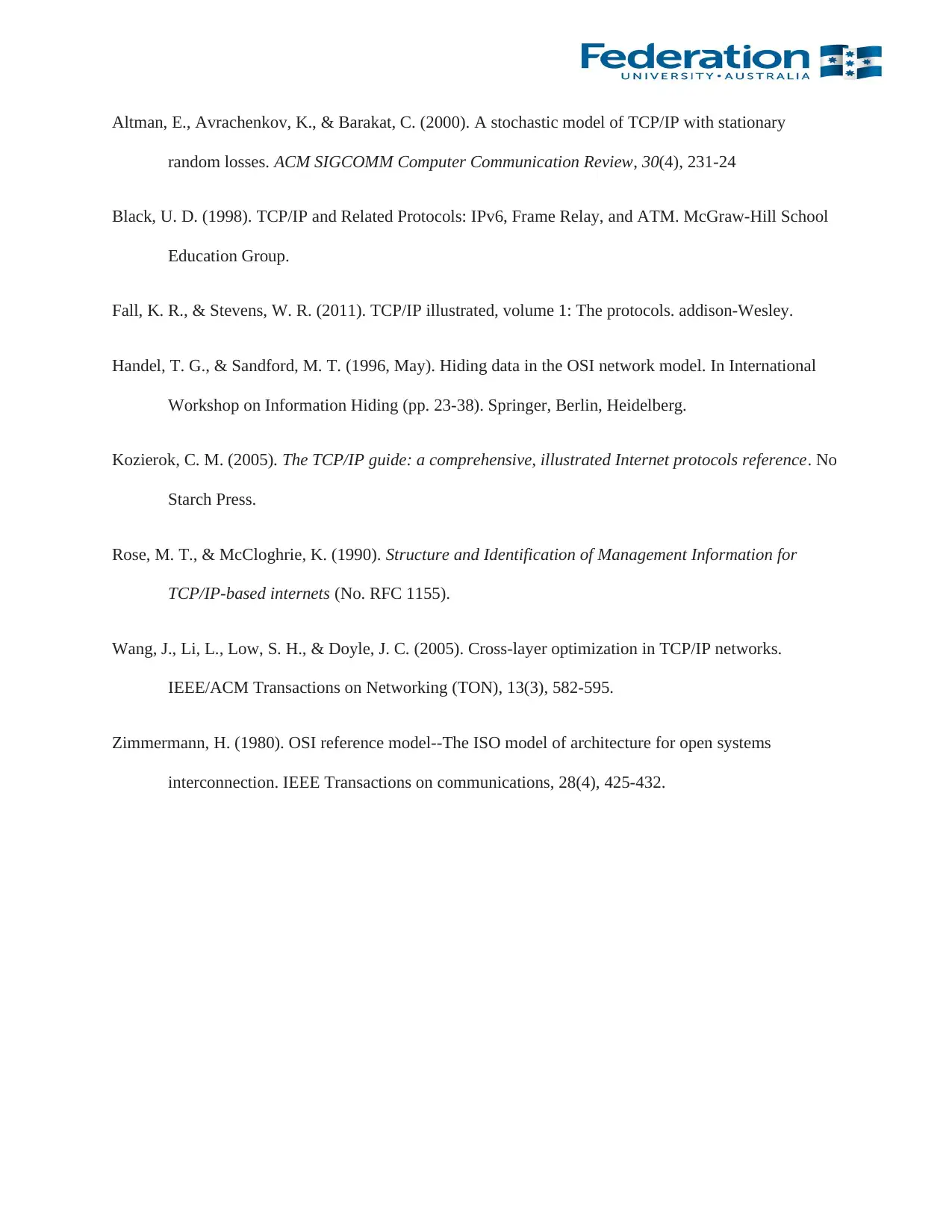
Altman, E., Avrachenkov, K., & Barakat, C. (2000). A stochastic model of TCP/IP with stationary
random losses. ACM SIGCOMM Computer Communication Review, 30(4), 231-24
Black, U. D. (1998). TCP/IP and Related Protocols: IPv6, Frame Relay, and ATM. McGraw-Hill School
Education Group.
Fall, K. R., & Stevens, W. R. (2011). TCP/IP illustrated, volume 1: The protocols. addison-Wesley.
Handel, T. G., & Sandford, M. T. (1996, May). Hiding data in the OSI network model. In International
Workshop on Information Hiding (pp. 23-38). Springer, Berlin, Heidelberg.
Kozierok, C. M. (2005). The TCP/IP guide: a comprehensive, illustrated Internet protocols reference. No
Starch Press.
Rose, M. T., & McCloghrie, K. (1990). Structure and Identification of Management Information for
TCP/IP-based internets (No. RFC 1155).
Wang, J., Li, L., Low, S. H., & Doyle, J. C. (2005). Cross-layer optimization in TCP/IP networks.
IEEE/ACM Transactions on Networking (TON), 13(3), 582-595.
Zimmermann, H. (1980). OSI reference model--The ISO model of architecture for open systems
interconnection. IEEE Transactions on communications, 28(4), 425-432.
random losses. ACM SIGCOMM Computer Communication Review, 30(4), 231-24
Black, U. D. (1998). TCP/IP and Related Protocols: IPv6, Frame Relay, and ATM. McGraw-Hill School
Education Group.
Fall, K. R., & Stevens, W. R. (2011). TCP/IP illustrated, volume 1: The protocols. addison-Wesley.
Handel, T. G., & Sandford, M. T. (1996, May). Hiding data in the OSI network model. In International
Workshop on Information Hiding (pp. 23-38). Springer, Berlin, Heidelberg.
Kozierok, C. M. (2005). The TCP/IP guide: a comprehensive, illustrated Internet protocols reference. No
Starch Press.
Rose, M. T., & McCloghrie, K. (1990). Structure and Identification of Management Information for
TCP/IP-based internets (No. RFC 1155).
Wang, J., Li, L., Low, S. H., & Doyle, J. C. (2005). Cross-layer optimization in TCP/IP networks.
IEEE/ACM Transactions on Networking (TON), 13(3), 582-595.
Zimmermann, H. (1980). OSI reference model--The ISO model of architecture for open systems
interconnection. IEEE Transactions on communications, 28(4), 425-432.
1 out of 6
Related Documents
Your All-in-One AI-Powered Toolkit for Academic Success.
+13062052269
info@desklib.com
Available 24*7 on WhatsApp / Email
![[object Object]](/_next/static/media/star-bottom.7253800d.svg)
Unlock your academic potential
© 2024 | Zucol Services PVT LTD | All rights reserved.





